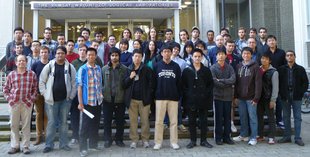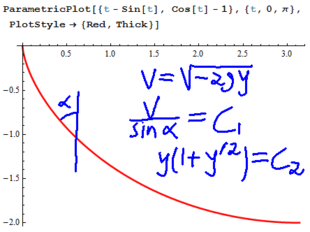12-267/Tuesday September 11 Notes: Difference between revisions
From Drorbn
Jump to navigationJump to search
m (Minor formatting edit) |
m (Corrected misspelling of Brachistochrone) |
||
| (One intermediate revision by the same user not shown) | |||
| Line 2: | Line 2: | ||
===Solving the complicated integral in the |
===Solving the complicated integral in the Brachistochrone integral=== |
||
<math>\int \sqrt{\frac{d-y}{y}} dy </math> |
|||
<math> = \int \sqrt{\frac{d y-y^2}{y}} dy </math> |
|||
Complete the square in the integrand: |
|||
<math> = \int \sqrt{\frac{\frac{d^2}{4} - (y - \frac{d}{2})^2}{y}} </math> |
|||
Substitute <math>u = y-\frac{d}{2}</math> and <math> du = dy </math>: |
|||
<math> = \int 2 \sqrt{\frac{\frac{d^2}{4} - u^2}{d+2 u}} du </math> |
|||
Assuming all variables are positive, substitute <math>u = \frac{1}{2} d \sin{s}</math> and <math>du = \frac{1}{2} d \cos{s} ds</math>. Then <math>\sqrt{\frac{d^2}{4} - u^2} = \sqrt{\frac{d^2}{4} - \frac{1}{4} d^2 \sin^2{s}} = \frac{1}{2} d \cos{s}</math> and <math>s = \sin^{-1}{\frac{2u}{d}}</math>: |
|||
<math> = \frac{d^2}{2} \int \frac{\cos^2{s}}{d \sin{s} + d} ds</math> |
|||
For the integrand substitute <math> p=\tan{\frac{s}{2}}</math> and <math>dp = \frac{1}{2} \sec^2{\frac{s}{2}} ds</math>. Then transform the integrand using the substitutions <math>\sin{s} = \frac{2p}{p^2 + 1}</math>, <math>\cos{s} = \frac{1-p^2}{p^2 + 1}</math> and <math>ds = \frac{2 dp}{p^2 + 1}</math>: |
|||
<math> = \frac{d^2}{2} \int 2 \frac{(1-p^2)^2}{(p^2 + 1)^3 (\frac{2 d p}{p^2 + 1} + d)} dp</math> |
|||
Simplify the integrand <math>\frac{2(1-p^2)^2}{(p^2 + 1)^3 (\frac{2 d p}{p^2 + 1} + d)}</math> to get <math>\frac{2 (p-1)^2}{d p^4 + 2 d p^2 + d}</math>: |
|||
<math> = \frac{d^2}{2} \int \frac{2(p-1)^2}{d p^4+2 d p^2+d} dp </math> |
|||
<math> = d^2 \int \frac{(p-1)^2}{d p^4+2 d p^2+d} dp </math> |
|||
<math> = d^2 \int \frac{(p-1)^2}{d (p^2+1)^2} dp </math> |
|||
<math> = d \int \frac{(p-1)^2}{(p^2+1)^2} dp </math> |
|||
For the integrand <math>\frac{(p-1)^2}{(p^2+1)^2}</math> use partial fractions: |
|||
<math> = d \int (\frac{1}{p^2+1}-\frac{2 p}{(p^2+1)^2}) dp</math> |
|||
<math> = d \int \frac{1}{(p^2+1)} dp - 2 d \int \frac{p}{(p^2+1)^2} dp</math> |
|||
For the integrand <math>\frac{p}{(p^2+1)^2}</math>, substitute <math>w = p^2+1</math> and <math>dw = 2 p dp</math>: |
|||
<math> = d \int \frac{1}{p^2+1} dp - d \int \frac{1}{w^2} dw </math> |
|||
The integral of <math>\frac{1}{p^2+1}</math> is <math>\tan^{-1}{p}</math>: |
|||
<math> = d \tan^{-1}{p}-d \int \frac{1}{w^2} dw</math> |
|||
<math> = d \tan^{-1}{p}+ \frac{d}{w}+constant</math> |
|||
Substitute back for <math>w = p^2+1</math>: |
|||
<math> = \frac{d ((p^2+1) tan^{-1}{p}+1)}{p^2+1}+C </math> |
|||
Substitute back for <math>p = \tan{\frac{s}{2}}</math>: |
|||
<math> = \frac{1}{2} d (\cos{s}+2 \tan^{-1}{\tan{\frac{s}{2}}}+1)+C </math> |
|||
Substitute back for <math>s = \sin^{-1}{\frac{2 u}{d}}</math>: |
|||
<math> = 1/2 (\sqrt{d^2-4 u^2}+2 d \tan^{-1}(\frac{2 u}{d \sqrt{1-\frac{4 u^2}{d^2}}+1)})+d)+C </math> |
|||
Substitute back for <math>u = y-\frac{d}{2}</math>: |
|||
<math> = d (-\tan^{-1}{\frac{d-2 y}{2 d \sqrt{\frac{y (d-y)}{d^2}}+d}})+\sqrt{y (d-y)}+\frac{d}{2}+C</math> |
|||
integral sqrt((d-y)/y) dy |
|||
= integral sqrt(d y-y^2)/y dy |
|||
For the integrand sqrt(d y-y^2)/y, complete the square: |
|||
= integral sqrt(d^2/4-(y-d/2)^2)/y dy |
|||
For the integrand sqrt(d^2/4-(y-d/2)^2)/y, substitute u = y-d/2 and du = dy: |
|||
= integral (2 sqrt(d^2/4-u^2))/(d+2 u) du |
|||
= 2 integral sqrt(d^2/4-u^2)/(d+2 u) du |
|||
For the integrand sqrt(d^2/4-u^2)/(d+2 u), (assuming all variables are positive) substitute u = 1/2 d sin(s) and du = 1/2 d cos(s) ds. Then sqrt(d^2/4-u^2) = sqrt(d^2/4-1/4 d^2 sin^2(s)) = 1/2 d cos(s) and s = sin^(-1)((2 u)/d): |
|||
= d^2/2 integral (cos^2(s))/(d sin(s)+d) ds |
|||
For the integrand (cos^2(s))/(d sin(s)+d), substitute p = tan(s/2) and dp = 1/2 sec^2(s/2) ds. Then transform the integrand using the substitutions sin(s) = (2 p)/(p^2+1), cos(s) = (1-p^2)/(p^2+1) and ds = (2 dp)/(p^2+1): |
|||
= d^2/2 integral (2 (1-p^2)^2)/((p^2+1)^3 ((2 d p)/(p^2+1)+d)) dp |
|||
Simplify the integrand (2 (1-p^2)^2)/((p^2+1)^3 ((2 d p)/(p^2+1)+d)) to get (2 (p-1)^2)/(d p^4+2 d p^2+d): |
|||
= d^2/2 integral (2 (p-1)^2)/(d p^4+2 d p^2+d) dp |
|||
= d^2 integral (p-1)^2/(d p^4+2 d p^2+d) dp |
|||
= d^2 integral (p-1)^2/(d (p^2+1)^2) dp |
|||
= d integral (p-1)^2/(p^2+1)^2 dp |
|||
For the integrand (p-1)^2/(p^2+1)^2, use partial fractions: |
|||
= d integral (1/(p^2+1)-(2 p)/(p^2+1)^2) dp |
|||
= d integral 1/(p^2+1) dp-2 d integral p/(p^2+1)^2 dp |
|||
For the integrand p/(p^2+1)^2, substitute w = p^2+1 and dw = 2 p dp: |
|||
= d integral 1/(p^2+1) dp-d integral 1/w^2 dw |
|||
The integral of 1/(p^2+1) is tan^(-1)(p): |
|||
= d tan^(-1)(p)-d integral 1/w^2 dw |
|||
= d tan^(-1)(p)+d/w+constant |
|||
Substitute back for w = p^2+1: |
|||
= (d ((p^2+1) tan^(-1)(p)+1))/(p^2+1)+C |
|||
Substitute back for p = tan(s/2): |
|||
= 1/2 d (cos(s)+2 tan^(-1)(tan(s/2))+1)+C |
|||
Substitute back for s = sin^(-1)((2 u)/d): |
|||
= 1/2 (sqrt(d^2-4 u^2)+2 d tan^(-1)((2 u)/(d (sqrt(1-(4 u^2)/d^2)+1)))+d)+C |
|||
Substitute back for u = y-d/2: |
|||
= d (-tan^(-1)((d-2 y)/(2 d sqrt((y (d-y))/d^2)+d)))+sqrt(y (d-y))+d/2+C |
|||
Factor the answer a different way: |
Factor the answer a different way: |
||
= 1/2 (-2 d tan^(-1)((d-2 y)/(2 d sqrt((y (d-y))/d^2)+d))+2 sqrt(y (d-y))+d)+C |
|||
<math> = \frac{1}{2} (-2 d \tan^{-1}{\frac{d-2 y}{2 d \sqrt{\frac{y (d-y)}{d^2}}+d}}+2 \sqrt{y (d-y)}+d)+C</math> |
|||
Which is equivalent for restricted y and d values to: |
Which is equivalent for restricted y and d values to: |
||
= y sqrt(d/y-1)-1/2 d tan^(-1)((sqrt(d/y-1) (d-2 y))/(2 (d-y)))+C |
|||
<math> = y \sqrt{\frac{d}{y}-1}-\frac{1}{2} d \tan^{-1}{\frac{\sqrt{\frac{d}{y}-1} (d-2 y)}{2 (d-y)}}+C</math> |
|||
[[User:Syjytg|Syjytg]] 23:00, 11 September 2012 (EDT) |
[[User:Syjytg|Syjytg]] 23:00, 11 September 2012 (EDT) |
||
Latest revision as of 17:20, 4 October 2012
| ||||||||||||||||||||||||||||||||||||||||||||||||||||||||||||
Solving the complicated integral in the Brachistochrone integral
Complete the square in the integrand:
Substitute and :
Assuming all variables are positive, substitute and . Then and :
For the integrand substitute and . Then transform the integrand using the substitutions , and :
Simplify the integrand to get :
For the integrand use partial fractions:
For the integrand , substitute and :
The integral of is :
Substitute back for :
Substitute back for :
Substitute back for :
Substitute back for :
Factor the answer a different way:
Which is equivalent for restricted y and d values to:
Syjytg 23:00, 11 September 2012 (EDT)











































